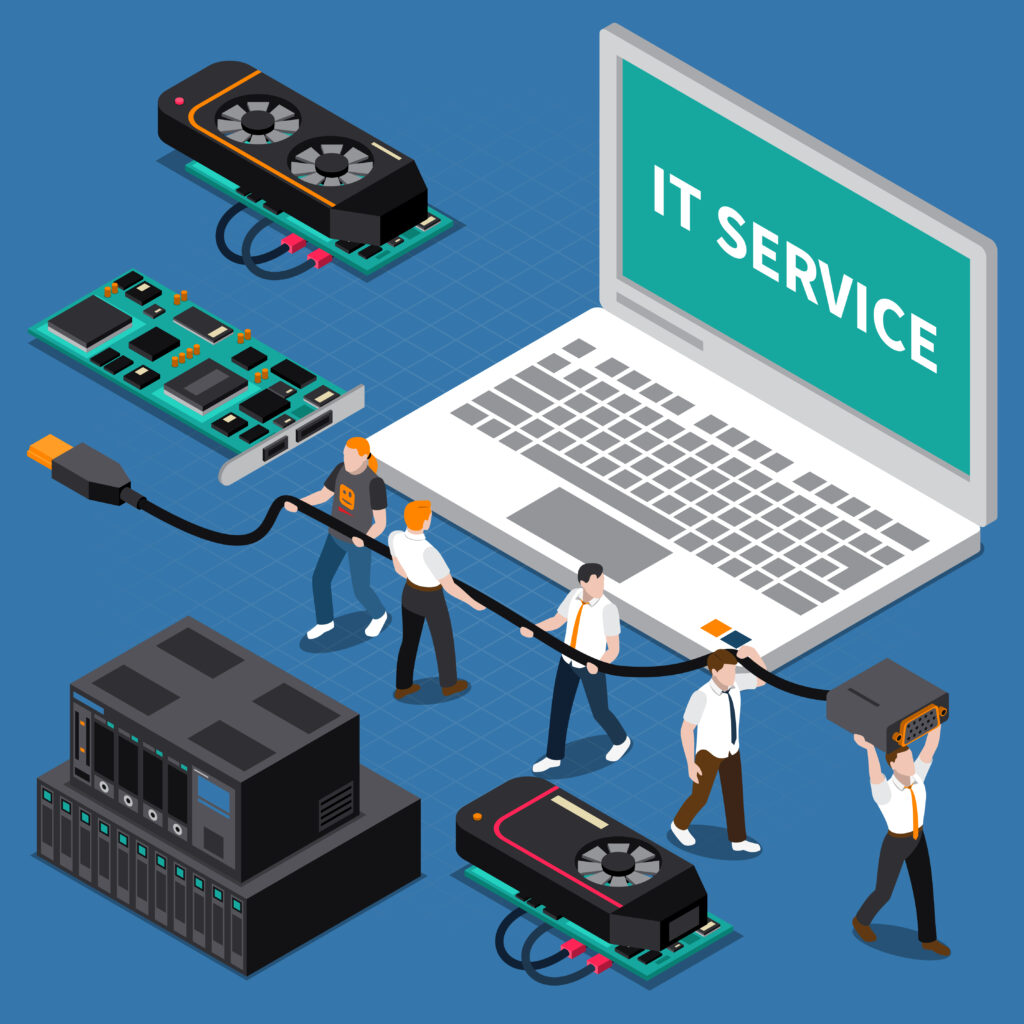Businesses, either small, medium, or companies need Tech and IT to boost their business. Technology, especially IT infrastructures, plays a huge role in individual daily activities and businesses. When running a small business, IT gadgets play important roles like increase productivity, reduce labor costs and free up time for more important tasks that you want to do.. To achieve the roles provided by these infrastructures, you must choose them correctly. While choosing, you need to consider appropriate hardware, software, and services to keep them running while using them for businesses. This article will discuss what you should consider when choosing the Choosing the Right Tech Tools for Small Businesses.
1. Examine the Scale of Needs
The first step is to know what your business needs. This will direct you to the functions your IT infrastructure should possess. When choosing tech tools for small businesses, examine your business needs, table down what functions of tools can help out, and research them. When examining your business needs, keep in mind the type of hardware, software, networks, and services that can be used to achieve those needs. This will not only set you in a proper direction, and also save cost operations.
Hardware tools for small businesses
Generally, Hardware tools for small businesses include Computers, Servers (File Servers, Application Servers), and Networking Equipment (Routers, Switches, Firewalls). Printers and Scanners (Multi-function Devices), Storage Solutions (External Hard Drives, Network Attached Storage), Point of Sale (POS) Systems (Cash Registers, POS Terminals), VoIP Phones.
Also Security Systems (Surveillance Cameras, Security Software), Power Protection (Uninterruptible Power Supply), and Mobile Devices (Smartphones, Tablets).
Software tools for Small businesses
Software tools for small businesses include Operating Systems, Productivity Suites, Industry-Specific Software, CRM Software, and Inventory Software.
For instance, a retail supermarket business will need important Hardware like Point of Sale (POS) Systems, Networking Equipment, Computers, Surveillance Cameras, and Mobile Devices.
Software like Point of Sale (POS) Software, Inventory Management Software, Security Software, Employee Scheduling Software, and Accounting Software. Also, IT Services include Network Setup and Maintenance, POS System Installation and Support, Data Backup and Recovery Services, Cybersecurity Services, and Technical Support.
2. Research on Hardware Specifications
After determining your business demands, choose IT devices that meet them. Hardware should be chosen initially. The first step in choosing small business tech tools is researching device specs. Analyzing and comprehending the business’s operational requirements guides device selection for everyday tasks.

Operational Analysis
Start the tech journey with a thorough operational review. This entails a detailed analysis of daily tasks to discover hardware-dependent regions. Every component needs consideration, whether it’s fast data processing for customer contacts, large storage for archiving, or field-based team mobility.
Considerations for Scalability
Buying gear that exceeds current demands is a strategic investment. Future corporate growth and technology changes depend on scalability. The chosen devices should fulfill current needs and effortlessly support business expansion.
As the firm grows, the hardware should be able to handle more transactions, data, and possibly more complicated point-of-sale systems.
Focus on Function
Beyond general hardware specs, functionality is key. Hardware must match business functions for seamless operations. This customization makes the business’s technology backbone a finely honed tool that boosts efficiency.
Consider a design-focused company that relies on graphics processing. Advanced graphics processors should be used in this hardware to ensure seamless design tasks for a visually focused business model.
3. Research on Software Programs that Satisfies Business Needs
The next critical step is to decide on software applications that meet unique company requirements. To find and use software that improves operational efficiency, analytical thinking is required. Your company’s operations, records, and financial security are all powered by software.
- Choose a program that caters to your sector and company’s unique set of requirements in terms of functionality.
- To avoid any incompatibilities, check to see if the software is compatible with your current setup.
- Select simple, intuitive software with a short learning curve and high return on investment.
- Protecting vital company information requires a top priority on software that includes multiple layers of security.
- Think of software that can expand in line with your business’s needs, handling larger data sets and more users as they come on board.
4. Choose a Safe and Secured Network Source
The digital foundation of any small business is its network source. Selecting a secure network involves evaluating internet service providers (ISPs) and implementing robust security measures to safeguard digital assets. When you have a good network provider, and even a secured one, it will be beneficial in the long run. The security is the most important thing to look for after the speed of the network. To further enhance your choice, look at the following features in your prospective network provider. Fast and dependable internet access is important when selecting an internet service provider (ISP).
Network Infrastructure
To guarantee optimum performance and security, make a significant investment in a strong network infrastructure, which includes firewalls, switches, and routers.
ISP Reliability
Look for dependable ISPs and select them. For company operations to continue without interruption, a reliable and fast internet connection is essential.
Security Protocols
Purchase firewalls and routers with cutting-edge security features. To protect sensitive data from potential cyber threats, implement encryption technologies.
Network Resilience
Make sure the network source you’ve chosen can tolerate any hiccups. Having a robust network is essential to keeping company connectivity constant.
5. Ensure User-Friendly Tools
After choosing the best tools for your business needs, it is essential to make them easily operable by the people that are to use them. When these tools are easily operable, even a nontech savvy employee will get them easily, especially the hardware that is not computers. When they are acquired, it is appropriate to train the workers on the proper use, and user-friendly tools make this faster. To Ensure this make the tools:
Select instruments using an easy-to-use interface: Your staff is more likely to use the tools efficiently if they find them easier to use.
Offer guidance and assistance: Ensure that your staff members receive the guidance and assistance they require to utilize the tools efficiently. User guides, online tutorials, and in-person training sessions can all be used to do this.
Encourage comments: Get input from your staff regarding the tools they are utilizing. You can use this feedback to determine where the tools need to be enhanced.
6. Invest in Cybersecurity
Data breaches and cyber threats are a significant concern for small businesses. Tech support can implement security measures, such as firewalls, antivirus software, and regular updates, to protect sensitive data from unauthorized access and potential loss. For even small businesses, cybersecurity is paramount, as hackers do not target them due to vulnerability. Here’s how to protect your business:

Educate Employees: Train your employees on cybersecurity best practices, such as strong password management and recognizing phishing attempts.
Implement Multi-Factor Authentication (MFA): Enable MFA for all critical accounts to add an extra layer of security.
Use Secure Cloud Services: Opt for reputable cloud service providers that offer robust security measures and compliance certifications.
Regular Security Audits: Conduct regular security audits to identify vulnerabilities and implement necessary security enhancements.
Incident Response Plan: Develop a comprehensive incident response plan to effectively address and mitigate security breaches.
7. Use Budget Friendly Tools
Limited resources are a common reality for small enterprises. It’s crucial to pick reasonably priced technology, but this must be done without compromising performance or safety.
Research and compare prices from various sellers to locate the most cost-effective options.
Open-source software is a free alternative to proprietary software that offers many of the same features.
Consider Using Cloud-Based Services Instead of Investing in Expensive On-Premise Infrastructure Hardware and upkeep costs can be greatly reduced by using cloud-based services.
Look for Bundled Deals Many companies may offer discounts or deals if you buy various products or services from them.
The ROI should be calculated to guarantee that the money spent on technology will help the company achieve its objectives.
8. Have a Reliable IT Support with Fast Response
IT supports help managed every tech gadgets you use in your business, This involves the maintainance, repair, and security. They also keep your business running. When you have break down in any devices, either hardware or software, your runtime will definitely be affected, especially if you run a business that carries frequent operations. For small business, it is best you outsource your IT support, and to the nearest service provider. This will save cost while aslo maintaining the speed of operations.

If you are in a city like Salt Lake city, you can easily get a tech support near you, that will be on standby for fast response. A good example is TickTockTech, they help local small businesses stay on track with their IT gadgets. Not only will they immediately send their technicians to your business place, but also get it done as fast as possible with no hidden charge (they provide free quote). This thereby saves your cost and time.
Conclusions
In conclusion, a strategic and analytical approach is necessary to design a technology blueprint that is suitable for a small organization. Every choice made about a company’s digital future—from its hardware specs to its software solutions, cybersecurity precautions, network redundancy, and budget constraints—is important.
The process of selecting appropriate technological resources is dynamic, changing in tandem with the development of the company and the state of the art in the field. With the correct resources, a small firm can not only improve efficiency but also set itself up for long-term success in today’s cutthroat digital market.

